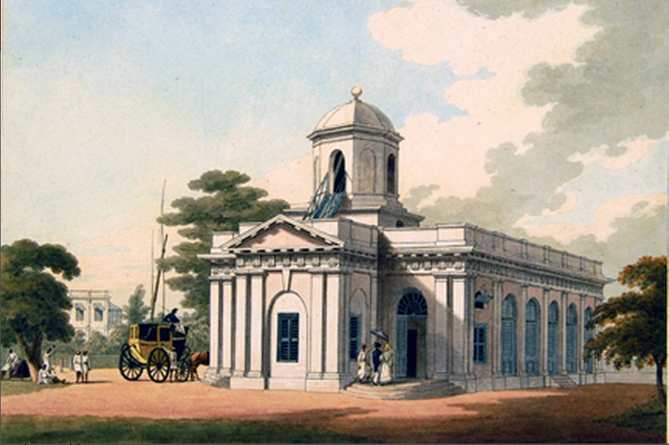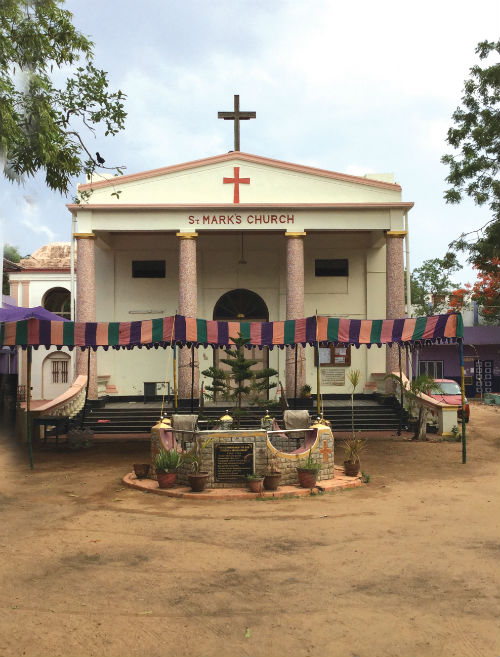Registered with the Registrar of Newspapers for India under R.N.I 53640/91
Vol. XXVII No. 8, August 1-15, 2017
Lost landmarks of Chennai
Sriram V
Kerr’s Church that Goldingham built
(Continued from last fortnight)

Julius Gantz’s engraving of the church Goldingham built.
Even though the Government had readily agreed to part funding a chapel in Black Town, there were some murmurs that the salary of a regular pastor would be a continuing charge. Kerr allayed these fears stating that he would minister to the parish free of cost and that this would be in addition to the time he spent at the Church of St. Mary’s in the Fort. John Goldingham, Government Astronomer, who would later design the Banqueting (Rajaji) Hall, planned the church and work began in 1798. It was completed a year later and on the first Sunday of 1800, the Rev. Kerr delivered the first sermon there. He would minister to the devout here every evening thereafter until his passing, except when he was away from the city or was unwell.
In 1802, Kerr proceeded to England to formally receive priest’s orders from the Archbishop. Returning to Madras in 1803 with a doctorate that he received from his alma mater in Dublin, Dr. Kerr, as he now was to be known, formally consecrated the Black Town chapel on February 5, 1804. He had received a special sanction from the Archbishop of Canterbury for this. It is interesting to note that there is a black stone plaque on the church’s gate post today that claims consecration to have been done in 1805!
Dr. Kerr became the senior chaplain of Madras in 1805 and from then on was a pillar of the church, with his influence being felt in Mysore, Malabar and elsewhere in Madras Presidency. He repeatedly petitioned the Government on matters ecclesiastical and also busied himself printing several Christian tracts, all of which were churned out by the press in the Asylum. He also interested himself in Freemasonry, joining the Lodge Perfect Unanimity, which, founded in 1786, is today the oldest surviving entity of its kind in South India. His career in that Order is not very edifying for he along with a few brothers from the same Lodge practically hijacked the workings of the Provincial Grand Lodge, the umbrella body in a Masonic District to which all Lodges are subordinate.

The church today.
But it was entirely due to his efforts that the Freemasons of the city began to donate generously to the Male Orphan Asylum. Long after his death, the Masons of Madras in 1823 would contribute to a building for the Asylum in Egmore. They also kept up the practice of awarding scholarships to deserving students from the Asylum and continued with it long after the institution was absorbed into the St. George’s School and Orphanage on Poonamallee High Road. It is noteworthy that plaques commemorating various donations by the Freemasons still survive within the school premises. Masonic interest in St. George’s would cease only in the 1980s.
Reverting to Dr. Kerr, he was laid low by a fever in 1808 and died the same year, on April 15, which happened to be Good Friday. He was laid to rest in the Black Town chapel.
And so we come to the present. Of parishioners, the Church has very few and services are conducted only on Sunday mornings. Its best years were clearly in the 19th Century. John Gantz, who left behind many views of Madras and who ran his famed lithographic press in Vyasarpadi, was one of the members of this church and also served as its trustee. Julius Walter Gantz of the same family did an engraving of the shrine in the 19th Century – it is featured here. When we compare it with the photograph taken recently we can see that the front of the chapel has changed for the worse.
The chapel appears to have had a wall with a window upfront with access from a door on the side. This is no longer the case, for the entrance has a flight of steps via which you access a pillared verandah and then the church. Closer inspection reveals that the present portico with the pillars is a later and most unfortunate addition. The original pilastered front is still there but now hidden by the portico. The window that was in the front has now made way for the main access.
It is also evident that the bell-tower, which in Gantz’s time appears to have been taller than the church, has somehow shrunk. Has it perhaps lost a storey? But it appears to be survivor from Goldingham’s design.
The chapel is very well maintained inside. The Rev. Dr. Kerr’s last resting place is right in the middle of the aisle and cannot be missed. Of considerable beauty is a monument to him on one of the walls of the church. This features a black obelisk on which some books are resting. The records of St. Mary’s Church in the Fort state that an organ was sent from there to this chapel sometime in the 1890s. That is nowhere to be seen now.
If the Rev. Kerr’s monument is majestic because of its size, that of the Rev. Morgan Davis, which adorns the opposite wall, is of white marble, small and very elegant. He became the pastor of St. Mark’s in 1810 and died at the Cape of Good Hope. The parishioners of St. Mark’s then erected this memorial to him. There are a couple of other plaques within the church. Reading some of them you realise that being chaplain of St. Mark’s also meant being Superintendent of the Civil Male Orphan Asylum, at least until 1880 or so, when it merged with its military counterpart and migrated elsewhere.
St. Mark’s is a church well worth a visit. The pastor is extremely friendly and is quite happy to get the caretaker to open the normally locked building and allow people to take a look around.
(Concluded)


Very happy to know the things in Chennai by net ,even though I am not in Chennai madras musings makes me happy ,keep itbup
Dear SIr or Madam This excellent article fascinated me. I am a later member of the Gantz family referenced above. I live in Australia so sadly I cannot visit Chennai at present. I am currently researching my family history to find out why there is this Indian connection and the origin story of it. I wondered whether you might know of the history or know how I can obtain details of the dates of birth and death of Julius or amy of his siblings, male or female. I believe his father was Justinian or John Gantz, both of whom died in the mid 19C, and whose records are often confused, but I do not have the name of the wife and mother. If you or any of your readers can assist me with any stories or dates I would be most grateful. I can be contacted via Facebook Messenger or at my email address, which is paulabarnett@outlook.com . Thank you so much! Yours faithfully, Paula Barnett